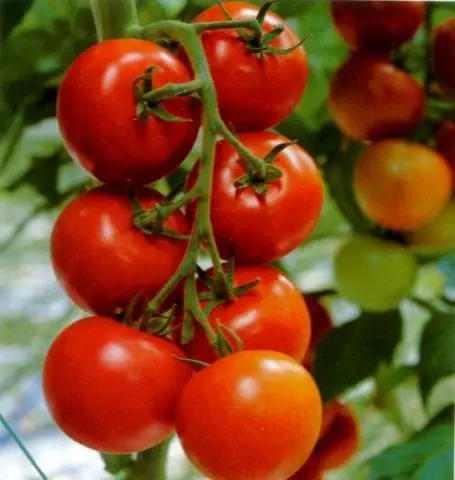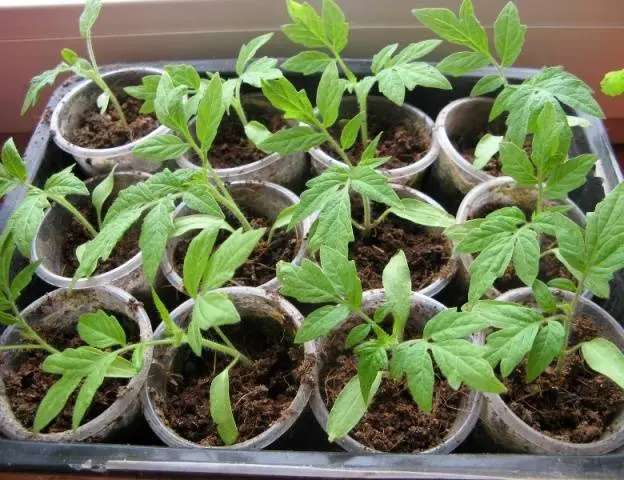Contents
Lovers of early tasty tomatoes grown in the sun, and preferably unpretentious ones, often plant the Oak variety, also known as Dubrava, which brings a large number of tomatoes.

Characteristics and description of the variety
The variety was bred back in the USSR for cultivation in open ground in Ukraine, Moldova and the south of the Federation and is well known to pensioners. In greenhouses, it can be grown further north. Fans of year-round fresh tomatoes, obtained on their own, manage to grow this variety of tomato even at home on the windowsill.
The state register “Dubok” is recommended for subsidiary and small farms. It is convenient in that the height of the bush does not exceed 70 cm, since the variety is determinant. The bush is powerful, not standard. It is recommended to form it in 3-4 stems. The variety does not have a special desire for branching and does not require pinching. The seed producer indicates that the bushes do not require tying, but the opinions of summer residents differ on this point. Unanimously noting the high yield, some confirm the uselessness of tying, others complain that the garter is necessary.
Perhaps it depends on the number of born tomatoes or the timeliness of the harvest. “Dubrava” – an early ripe variety of tomatoes. The average fruit ripening period is 95 days. The bush bears fruit until late autumn. With a plentiful harvest or irregular collection of ripened fruits, the bushes may indeed not withstand the load. On average, you can get 2 kg of tomatoes from a bush, but with good care and systematic collection of ripe tomatoes, “Dubok” can bring up to 5 kg from one bush. To obtain a bountiful harvest, it is necessary to provide each bush of the Dubrava variety with a living space of 0,3×0,4 m. Planting cannot be thickened.
Tomatoes “Dubok” vary in weight from 50 to 130 g. It is noted that if you plant seedlings under a film, then the fruits are larger. The color of a ripe tomato is bright red. The pulp is dryish, hard. Tomatoes can be plucked brown, they ripen within a few days. Tomatoes are distinguished by good taste and versatility. They are well suited for the preservation and preparation of ketchups and vegetable mixtures. When fresh, they give a slightly sour taste to vegetable salads.
The photo clearly shows the quality of the pulp of tomatoes.

The fruits have excellent keeping quality and the ability to be stored for up to one and a half months, resistant to cracking. Well transfer transportation, keeping a trade dress. These qualities have made them attractive to small growers.
Features
“Oakwood” is a relatively frost-resistant plant. It is also resistant to common tomato diseases. The advantages include the relative indifference of the variety to drought and high humidity. While other varieties of tomatoes require almost ideal humidity conditions.
But there is also a fly in the ointment in this barrel of honey: at the time of pollination, the air temperature should not be higher than 25 ° C, otherwise the flowers will not be pollinated.
At elevated air temperatures, the harvest will also be impressive, but the size of the tomatoes will be smaller than that declared by the manufacturer.
An important plus is the ability of “Dubrava” to grow equally well on heavy soils and on sand.
Summer residents noted the friendly germination of seeds of the “Dubok” tomato with a minimum germination rate of 87%, usually 100% germinates.
The undoubted advantage of the variety is the ability to collect seeds for the next season. Tomatoes “Dubok” taste similar to the Richie variety, which is a hybrid of the first generation, and, therefore, does not produce the same variety from seeds. Dubrava does not have this drawback.
Why seeds don’t germinate
Even in such an unpretentious variety, as described by the manufacturer “Oak”, the seeds may not germinate. It’s not always about seeds.

There are quite a few serious reasons for the death of seeds:
- if you took seeds from friends, acquaintances or from private traders in the market, you could buy infected seeds. Unchecked seeds must be disinfected before sowing;
- an infection may also be present in the seedling soil, even if it was bought in a store (and if you also remember the desire of some store owners to save money by gathering soil in the nearest forest);
- the presence of toxic substances in the soil;
- an excess of salts in the soil;
- the soil is too heavy and dense;
- too deep sowing of seeds;
- low air temperature. In this case, germination slows down and seedlings can rot in the ground;
- excess water. High humidity coupled with low temperature can lead to rotting of seedlings even with well-performed sowing;
- acidic soil. Tomatoes prefer at least neutral soil;
- seeds stored for a long time at a low temperature “fall into hibernation.” They will come out of this state only after 2-3 weeks or not come out at all.
The manufacturer is not always to blame for the fact that the seeds did not sprout, sometimes other factors prevent the appearance of sprouts.
Reviews of summer residents about the tomato “Dubok”
Surprisingly, they are unanimous in a positive assessment of the variety.
Planted. Compared to our usual varieties, I was struck by the number of tomatoes, although due to the heat, some of the leaves and stems simply withered.
Conclusion
Tomato “Dubrava” has been popular for many years for a reason. Although its fruits are not large, there are many of them and they ripen together. And due to the fact that about forty years ago, breeders did not seek to develop highly productive hybrids that were unable to produce seeds, this tomato breaks the circle “shop-seeds-sowing-harvesting-shop” for the summer resident. Seeds of the variety “Oak” can be harvested independently.









